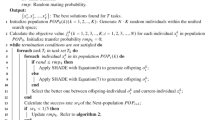Abstract
Despite the success enjoyed by the EMT search paradigm, it is worth noting that the implicit EMT algorithms introduced in Chaps. 3 and 4 are designed based on the unified solution representation, and the knowledge sharing across tasks for problem-solving is realized by the implicit genetic transfer in chromosomal crossover.
Access this chapter
Tax calculation will be finalised at checkout
Purchases are for personal use only
Similar content being viewed by others
Notes
- 1.
We do not use unified representation for all the tasks as in [19]. Each task uses its own solution representation. For example, suppose we are given two tasks, i.e., one is 50 dimension Ackley function, while the other is 100 dimension Sphere function. Then the real coded solutions with 100 and 50 dimension are used for Ackley and Sphere, respectively.
- 2.
Note that p and q may have different dimensions, and we pad p or q with zeros to make both problems be of equal dimensionality.
- 3.
The inter-task similarity is defined based on the Pearson correlation [136]. A higher value denotes greater similarity between tasks.
- 4.
The inter-task similarity is defined based on the Pearson correlation [137]. A higher value denotes greater similarity between tasks.
- 5.
D is the dimensionality of the encoded solution. For MOMFEA, it is the dimensionality of the unified code representation.
References
A. Gupta, Y.S. Ong, L. Feng, Multifactorial evolution: toward evolutionary multitasking. IEEE Trans. Evolut. Comput. 20(3), 343–357 (2016)
A. Gupta, Y.S. Ong, L. Feng, K.C. Tan, Multi-objective multifactorial optimization in evolutionary multitasking. IEEE Trans. Cybernet. 47(7), 1652–1665 (2017)
K. Deb, A. Pratap, S. Agarwal, T. Meyarivan, A fast and elitist multiobjective genetic algorithm: NSGA-II. IEEE Trans. Evolut. Comput. 6(2), 182–197 (2002)
B. Da, Y.S. Ong, L. Feng, A.K. Qin, A. Gupta, Z. Zhu, C.K. Ting, K. Tang, X. Yao, Evolutionary multitasking for single-objective continuous optimization: benchmark problems, performance metric, and baseline results. Preprint. arXiv:1706.03470 (2017)
Y. Yuan, Y.S. Ong, L. Feng, A.K. Qin, A. Gupta, B. Da, Q. Zhang, K.C. Tan, Y. Jin, H. Ishibuchi, Evolutionary multitasking for multiobjective continuous optimization: Benchmark problems, performance metrics and baseline results (2017). Preprint. arXiv:1706.02766
M. Iqbal, B. Xue, H.A.-Sahaf, M. Zhang, Cross-domain reuse of extracted knowledge in genetic programming for image classification. IEEE Trans. Evolut. Comput. 21(4), 569–587 (2017)
D. O’Neill, H.A.-Sahaf, B. Xue, M. Zhang, Common subtrees in related problems: a novel transfer learning approach for genetic programming. Proceedings of 2017 IEEE Congress on Evolutionary Computation (CEC 2017), 2017, pp. 1287–1294
L.J. Eshelman, R. Caruana, J.D. Schaffer, Biases in the crossover landscape, in Proceedings of the 3rd International Conference on Genetic Algorithms, 1989, pp. 10–19
K.F. Man, K.S. Tang, S. Kwong, Genetic algorithms: concepts and applications [in engineering design]. IEEE Trans. Ind. Electron. 43(5), 519–534 (1996)
I. Goodfellow, Y. Bengio, A. Courville, Deep Learning (MIT Press, Cambridge, 2016) http://www.deeplearningbook.org
A. Krizhevsky, I. Sutskever, G.E. Hinton, Imagenet classification with deep convolutional neural networks, in Proceedings of the 25th International Conference on Neural Information Processing Systems, NIPS’12 (2012), pp. 1097–1105
A. Bordes, X. Glorot, J. Weston, Y. Bengio, Joint learning of words and meaning representations for open-text semantic parsing, in International Conference on Artificial Intelligence and Statistics, 2012, pp. 127–135
X. Glorot, A. Bordes, Y. Bengio, Domain adaptation for large-scale sentiment classification: A deep learning approach, in Proceedings of the Twenty-eight International Conference on Machine Learning, ICML’11, 2011, pp. 97–110
L. Feng, Y.S. Ong, S. Jiang, A. Gupta, Autoencoding evolutionary search with learning across heterogeneous problems. IEEE Trans. Evolut. Comput. (in press, 2017)
A. Graves, M. Liwicki, S. Fernández, R. Bertolami, H. Bunke, J. Schmidhuber, A novel connectionist system for unconstrained handwriting recognition. IEEE Trans. Patt. Anal. Mach. Intell. 31(5), 855–868 (2009)
P. Vincent, H. Larochelle, I. Lajoie, Y. Bengio, P.A. Manzagol, Stacked denoising autoencoders: Learning useful representations in a deep network with a local denoising criterion. J. Mach. Learn. Res. 11, 3371–3408 (2010)
C. Bishop, Pattern Recognition and Machine Learning (Springer, New York, 2006)
M. Potter, K. De Jong, Cooperative coevolution: An architecture for evolving coadapted subcomponents. Evol. Comput. 8(1), 1–29 (2000)
R.B. Agrawal, K. Deb, R.B. Agrawal, Simulated binary crossover for continuous search space. Complex Syst. 9(2), 115–148 (1995)
R. Storn, K. Price, Differential evolution - a simple and efficient heuristic for global optimization over continuous spaces. J. Global Optim. 11(4), 341–359 (1997)
E. Zitzler, M. Laumanns, L. Thiele, Spea2: improving the strength pareto evolutionary algorithm, in Proceedings of Evolutionary Methods for Design, Optimisation and Control with Application to Industrial Problems (EUROGEN), pp. 95–100 (2001)
Author information
Authors and Affiliations
Rights and permissions
Copyright information
© 2023 The Author(s), under exclusive license to Springer Nature Singapore Pte Ltd.
About this chapter
Cite this chapter
Feng, L., Gupta, A., Tan, K., Ong, Y. (2023). Explicit Evolutionary Multi-Task Optimization Algorithm. In: Evolutionary Multi-Task Optimization. Machine Learning: Foundations, Methodologies, and Applications. Springer, Singapore. https://doi.org/10.1007/978-981-19-5650-8_5
Download citation
DOI: https://doi.org/10.1007/978-981-19-5650-8_5
Published:
Publisher Name: Springer, Singapore
Print ISBN: 978-981-19-5649-2
Online ISBN: 978-981-19-5650-8
eBook Packages: Computer ScienceComputer Science (R0)




